Currency
The death of the dollar is coming, and it will probably be China that pulls the trigger. What you are about to read is understood by only a very small fraction of all Americans. Right now, the U.S. dollar is the de facto reserve currency of the planet. Most global trade is conducted in U.S. dollars, and almost all oil is sold for U.S. dollars. More than 60 percent of all global foreign exchange reserves are held in U.S. dollars, and far more U.S. dollars are actually used outside of the United States than inside of it. As will be described below, this has given the United States some tremendous economic advantages, and most Americans have no idea how much their current standard of living depends on the dollar remaining the reserve currency of the world. Unfortunately, thanks to reckless money printing by the Federal Reserve and the reckless accumulation of debt by the federal government, the status of the dollar as the reserve currency of the world is now in great jeopardy.
As I mentioned above, nations all over the globe use U.S. dollars to trade with one another. This has created tremendous demand for U.S. dollars and has kept the value of the dollar up. It also means that Americans can import things that they need much more inexpensively than they otherwise would be able to.
 The largest exporting nations such as Saudi Arabia (oil) and China (cheap plastic trinkets at Wal-Mart) end up with massive piles of U.S. dollars…
The largest exporting nations such as Saudi Arabia (oil) and China (cheap plastic trinkets at Wal-Mart) end up with massive piles of U.S. dollars…
Instead of just sitting on all of that cash, these exporting nations often reinvest much of that cash into low risk securities that can be rapidly turned back into dollars if necessary. For a very long time, U.S. Treasury bonds have been considered to be the perfect way to do this. This has created tremendous demand for U.S. government debt and has helped keep interest rates super low. So every year, massive amounts of money that gets sent out of the country ends up being loaned back to the U.S. Treasury at super low interest rates…
And it has been a very good thing for the U.S. economy that the federal government has been ableto borrow money so cheaply, because the interest rate on 10 year U.S. Treasuries affects thousands upon thousands of other interest rates throughout our financial system. For example, as the rate on 10 year U.S. Treasuries has risen in recent months, so have the rates on U.S. home mortgages.
Our entire way of life in the United States depends upon this game continuing. We must have the rest of the world use our currency and loan it back to us at ultra low interest rates. At this point we have painted ourselves into a corner by accumulating so much debt. We simply cannot afford to have rates rise significantly.
For example, if the average rate of interest on U.S. government debt rose to just 6 percent (and it has been much higher than that at various times in the past), we would be paying more than a trillion dollars a year just in interest on the national debt.
But it wouldn’t be just the federal government that would suffer. Just consider what higher rates would do to the real estate market.
About a year ago, the rate on 30 year mortgages was sitting at 3.31 percent. The monthly payment on a 30 year, $300,000 mortgage at that rate is $1315.52.
If the 30 year rate rises to 8 percent, the monthly payment on a 30 year, $300,000 mortgage would be $2201.29.
Does 8 percent sound crazy to you?
….read page 2 HERE

 Proving that idiocy truly has no bounds, Spain issued a “royal decree” taxing sunlight gatherers. The state threatens fines as much as 30 million euros for those who illegally gather sunlight without paying a tax.
Proving that idiocy truly has no bounds, Spain issued a “royal decree” taxing sunlight gatherers. The state threatens fines as much as 30 million euros for those who illegally gather sunlight without paying a tax.
The tax is just enough to make sure that homeowners cannot gather and store solar energy cheaper than state-sponsored providers.
Via Mish-modified Google Translate from Energias Renovables, please consider Photovoltaic Sector, Stunned
The Secretary of State for Energy, Alberto Nadal, signed a draft royal decree in which consumption taxes are levied on those who want to start solar power systems on their rooftops. The tax, labeled a “backup toll” is high enough to ensure that it will be cheaper to keep buying energy from current providers.
Spain Privatizes the Sun
Via Google translate from El Pais, please consider Spain Privatizes The Sun
If you get caught collecting photons of sunlight for your own use, you can be fined as much as 30 million euros.
If you were thinking the best energy option was to buy some solar panels that were down 80% in price, you can forget about it.
“Of all the possible scenarios, this is the worst,” said José Donoso, president of the Spanish Photovoltaic Union (UNEF), which represents 85% of the sector’s activity.
Before the decree it took 12 years to recover the investment in a residential installation of 2.4 kilowatts of power. Following the decree, it will take an additional 23 years according to estimates by UNEF.
Petition of the Candle Makers Revisited
And so the “Petition of the Candle Makers” comes to pass.
I have written about the “petition” on many occasions, but here is the latest reference: Extremely Difficult to Keep Up With Economic Stupidity
Reflections on “Unfair Competition”
Corporations always consider it “unfair” when any other company can do things faster, smarter, or cheaper than they can. The buggy whip industry once protested cars.
Today, land-line telecom companies have to compete with wireless and they don’t like it. Now, we see protests about VOIP (voice over internet protocol).
Technology marches on. But France does not like it. The French solution is to tax Skype because it has an “unfair advantage“.
This is an age-old unwinnable argument.
Petition of the Candle Makers
The ultimate irony is France’s preposterous “unfair advantage” argument was lampooned by French economist Frederic Bastiat back in 1845 when he penned ‘Petition of the Candle Makers‘.
In his article, candle makers were incensed that the light of the sun could be had for free. The sun’s unfair trade advantage was to the “detriment of fair industries” who could not compete against the sun’s price.
Something had to be done to “shut off as much as possible, all access to natural light, and thereby create a need for artificial light” so that “industry in France will encouraged”.
The moral to this story is “Don’t propose something purposefully stupid hoping to make a point. Some idiot might actually think it’s a good idea and do it”.
Mike “Mish” Shedlock
http://globaleconomicanalysis.blogspot.com
Read more at http://globaleconomicanalysis.blogspot.com/2013/07/spain-levies-consumption-tax-on-sunlight.html#k7liqm6ZudIqHw0F.99

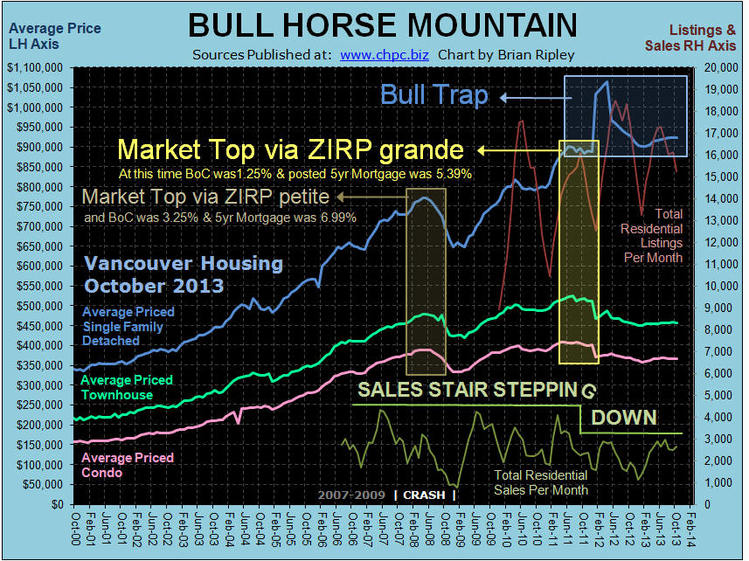
Notice on the chart above that during the labelled periods ZIRP grande and ZIRP petite, all three Vancouver residential housing sectors sold off in price and total number of residential sales. A significant difference was that during ZIRP grande, single family detached housing diverged from the whole market and produced a false trend change signal and went on to zoom into the blow off phase adding another 20% to the price which has mostly evaporated.
….whole article HERE

Too Damn Bullish
- Sentiment extremes flash warning signs
- Sleepwalking investors are finally buying
- Plus: What’s price telling us right now?
The individual investor is back. And he’s too damn bullish, according to about 5,000 reports I stumbled upon over the weekend.
In fact, the “everyone’s too bullish” theme is boiling over into the workweek.
“Stocks Regain Broad Appeal” reads the headline splashed across the front page of the Wall Street Journal this morning…
Of course, stories like this one are filled with quotes from Ma and Pa Investor who just received their third quarter statements in the mail. After sleepwalking through the first four years of this market rally, they’re finally ready to buy in now that they see those always-elusive market gains coming back to life.
Let’s check the stats to find out just where the super-bulls stand:
“A particularly worrisome [measure] is the Investors Intelligence gauge of adviser sentiment. Its last reading showed that 55.2% of respondents were bullish and just 15.6% bearish, tying the highest difference between the two this year,” reads yet another WSJ report. “The last time the gap was bigger was April 8, 2011, which preceded the sharpest stock-market correction of the current bull market.”
Yikes.
On the other hand, there’s also evidence that investors are getting cautious as the broad market reaches toward new highs.
According to Bank of America Merrill Lynch Global Research, investors pulled $7.5 billion from U.S. equity funds last week. Financial and tech names lost the most coin as investors fled to money market funds…
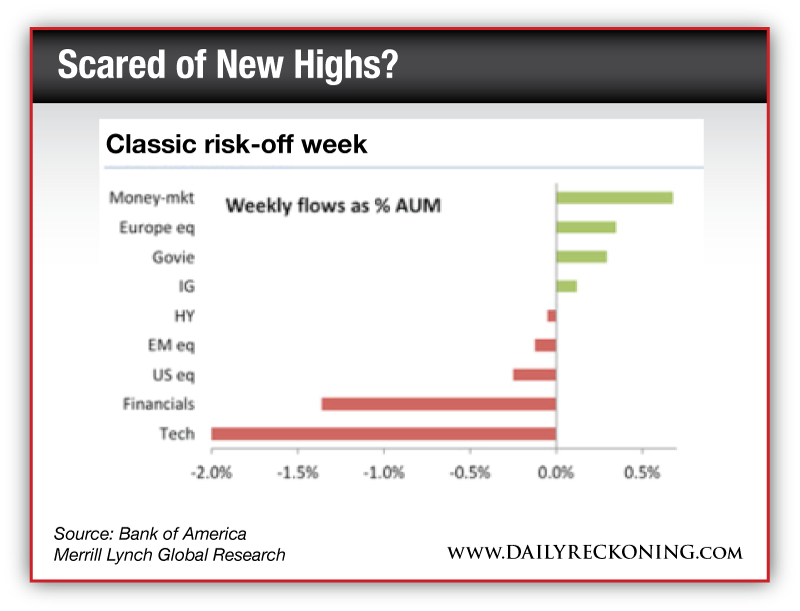
While more investors are embracing the stock market as this year’s historic rally continues to unfold, there’s still a healthy amount of fear out there.
Yes, our end-of-year momentum rally was put on hold late last week. But strong buying Friday proves we’re still in a “buy the dips” market for now. Sentiment extremes could continue to rattle the market as we head into the final stretch of 2013. But until price breaks down, the benefit of the doubt belongs to the rally…
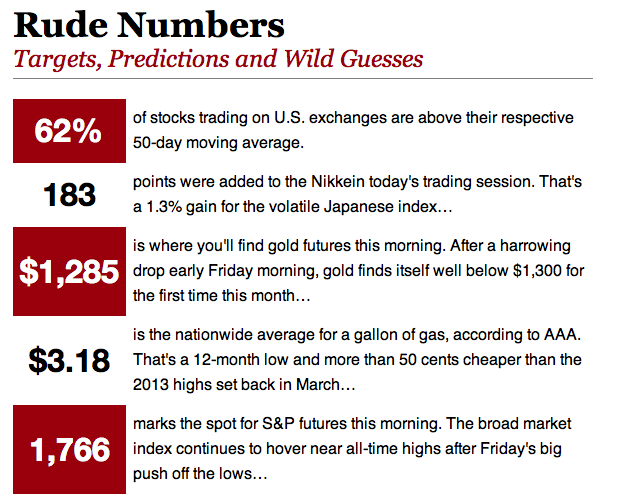
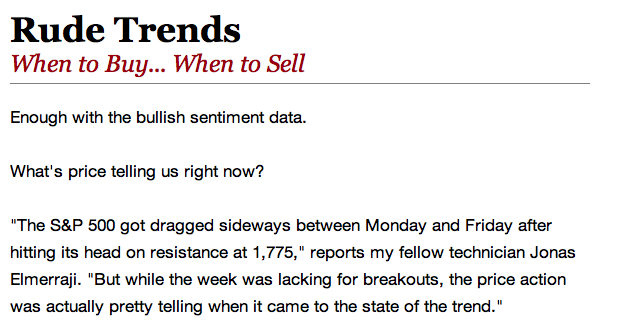
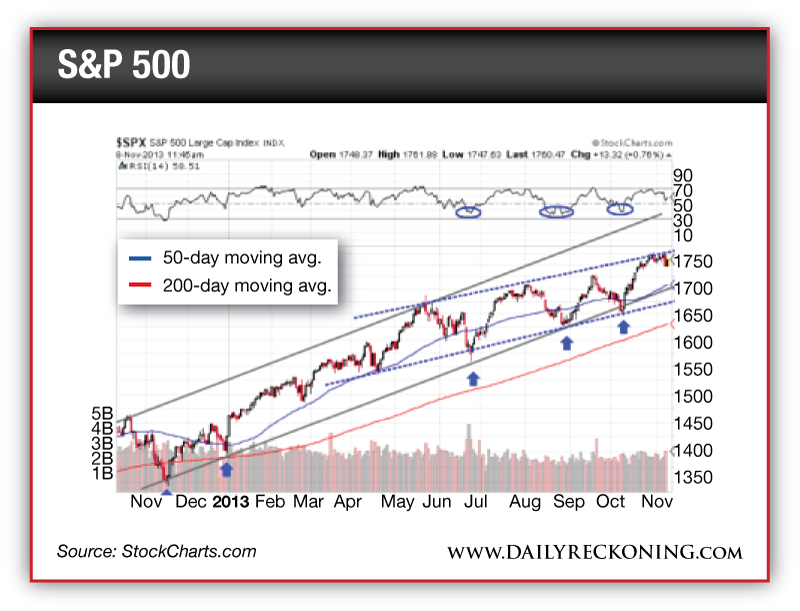
“In the chart above, I’ve annotated the current long-term uptrend in grey,” Jonas continues. “But there’s another uptrend in play that’s marked off by the dashed blue trendlines. So, which one is the ‘correct’ uptrend for stocks? Well, both of them are right now…
“The fact that Mr. Market is hitting his head on resistance at that dashed line definitely gives me more confidence in its ability to hold the S&P’s price action this fall. But we’ll really see which of the two trends wins out on the next move back down to support.”
Right now, Jonas is patiently stalking a new trade. Join him today so you won’t miss his next potentially profitable move…
[Ed. Note: Send your feedback here: rude@agorafinancial.com – and follow me on Twitter: @GregGuenthner]
P.S. Starting November 18th we’ll be delivering the Rude Awakening to you from a different email address: rude@agorafinancial.com. To be sure you won’t miss a single issue, take the time to whitelist this address right now…
And of course, we always welcome feedback from our readers. If you have any questions about this free subscription upgrade, send us an email atrude@agorafinancial.com.












